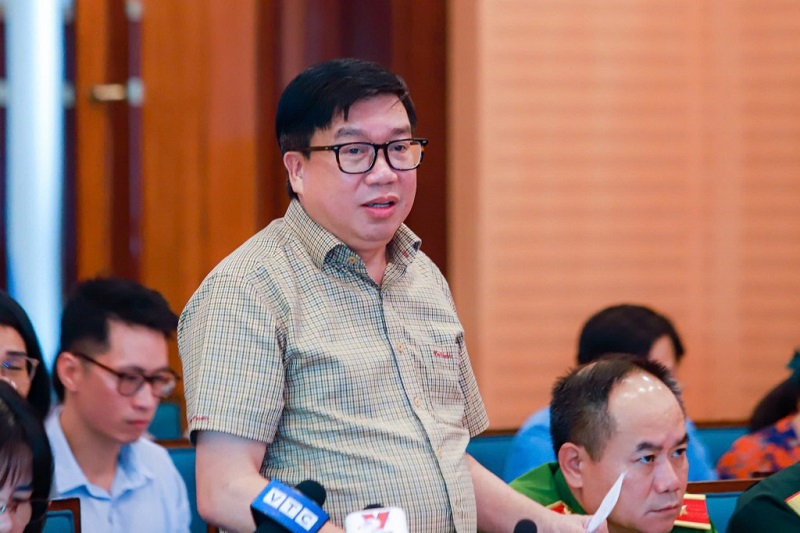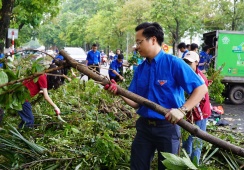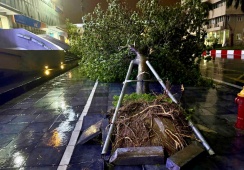
Typhoon Yagi has taught Hanoi valuable lessons on how to preserve and manage urban greenery in the midst of the city's dire climate change challenges. Nguyen Duc Hung, Director of the Technical Infrastructure Management Center of the Hanoi Department of Construction, discusses Hanoi's green maintenance with the online publication Thoi Nay.
| Nguyen Duc Hung, Director of the Technical Infrastructure Management Center of the Hanoi Construction Department. |
What lessons can be drawn from the work of removing fallen trees after Typhoon Yagi?
One of Hanoi's biggest losses in terms of storm-damaged property was downed trees. However, the drainage system was our biggest concern at the time of the typhoon, and local officials had prepared a number of scenarios, including evacuation plans, to keep people safe and healthy. Fortunately, the worst-case scenario did not materialize.
We deployed 100% of our personnel and equipment to clear fallen trees and repair damaged lighting and electrical systems after the typhoon. We received support from colleagues in 10 provinces and cities, and the number of professionals involved totaled up to 1,000. Each district also mobilized about 1,000 people from the police, army, youth union and women's union.
Thanks to a quick response, many trees were saved and revived after the typhoon. Of the 14,700 fallen urban trees, we replanted 3,500 in their original locations and sent 600 to the nursery for rehabilitation. Most of the heritage trees were saved, and the local authorities are planning replanting projects to be implemented as soon as possible.
The typhoon uprooted many trees, some of which still have their root wraps intact or have wide canopies that have not been pruned. Why were the pruning and unwrapping not done before the typhoon?
Of the nearly 12,000 uprooted urban trees, 12 were found with intact root wrap, the material that doesn't decompose and undermines the ability of roots to grow. This shows that some contractors were too lax in their work. Since 2014-2015, the city government has been closely monitoring these practices, but Typhoon Yagi clearly proved that many trees were planted the wrong way. We are now tracking down those contractors who are responsible for this misdeed.
In principle, a tree's roots should extend as far as its canopy. However, urban trees are often planted over telecommunications lines, underground electrical cables, and drainage systems. As a result, the roots don't extend as deep and wide as the canopy. Most trees in the city center were planted before modern infrastructure was built, so we need to balance tree planting with infrastructure development. However, the demand for green spaces is high, so the two must coexist. For this reason, the number of trees uprooted in Hanoi during the typhoon was relatively high.
| Soldiers clear fallen trees in Ba Dinh district. Photo: The Hanoi Times |
What are Hanoi's long-term strategies to improve the preservation and development of urban greenery?
Restoring urban ecosystems and greening public spaces is the best way to bring the values of nature back to today's cities. Underground infrastructure and tree planting shouldn't cross paths in new urban developments. The Capital Law 2024, which will soon be detailed by the city's People's Council, provides specifics on how to protect trees and increase tree coverage in Hanoi.
To better care for the trees, we plan to use ultrasound technology to detect decay and disease early. In addition, our center is digitizing tree data for electronic management, which we hope to complete by the end of the year. We give each tree a profile with an ID number that includes comprehensive details about its age, current physical condition, and more. We will try to digitize the data of all the heritage trees and those planted in the central city. Then we will do it for all the trees in the city.
Will there be digitization of other technical infrastructures in response to unexpected weather events?
The software I mentioned will also integrate databases on drainage, lighting, traffic cameras, smart streetlights, and flood alerts. In principle, infrastructure management decisions such as drainage, flood control, lighting, and tree maintenance and pruning should be based on data.
In the future, with the further development of 5G telecommunications technology and its wider coverage, Hanoi will transform into a smart city. Digitalization will make infrastructure management more precise and timely, especially in unusually unexpected situations brought about by climate change.
Thank you for your time!



